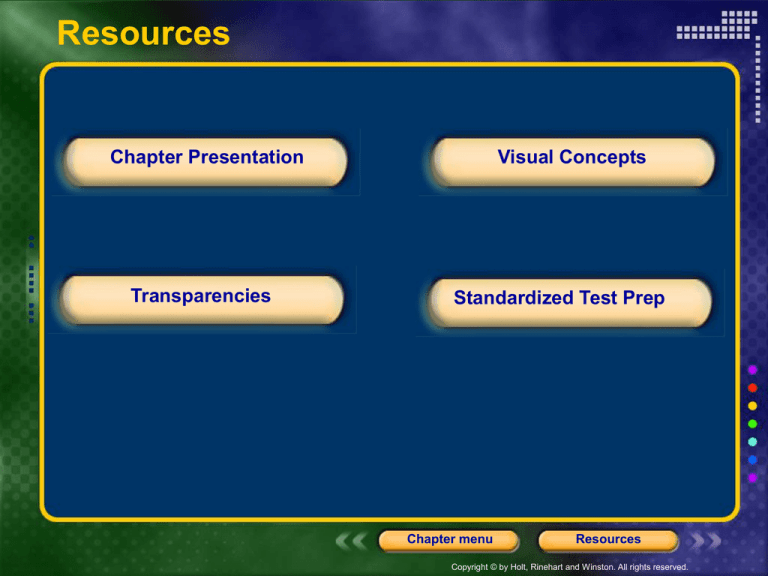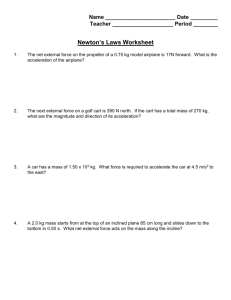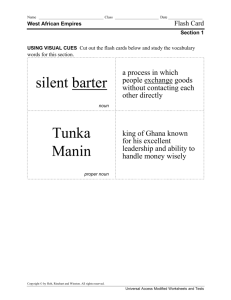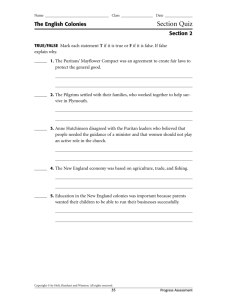
Resources
Chapter Presentation
Transparencies
Visual Concepts
Standardized Test Prep
Chapter menu
Resources
Copyright © by Holt, Rinehart and Winston. All rights reserved.
Chapter 7
Cellular Respiration
Table of Contents
Section 1 Glycolysis and Fermentation
Section 2 Aerobic Respiration
Chapter menu
Resources
Copyright © by Holt, Rinehart and Winston. All rights reserved.
Chapter 7
Section 1 Glycolysis and Fermentation
Objectives
• Identify the two major steps of cellular respiration.
• Describe the major events in glycolysis.
• Compare lactic acid fermentation with alcoholic
fermentation.
• Calculate the efficiency of glycolysis.
Chapter menu
Resources
Copyright © by Holt, Rinehart and Winston. All rights reserved.
Fig. 9-1
Chapter menu
Resources
Copyright © by Holt, Rinehart and Winston. All rights reserved.
Fig. 9-2
Light
energy
ECOSYSTEM
Photosynthesis
in chloroplasts
Organic
+O
molecules 2
CO2 + H2O
Cellular respiration
in mitochondria
ATP
ATP powers most cellular work
Heat
energy
Chapter menu
Resources
Copyright © by Holt, Rinehart and Winston. All rights reserved.
Fig. 9-6-3
Electrons carried
via NADH and
FADH2
Electrons
carried
via NADH
Pyruvate
Glucose
Oxidative
phosphorylation:
electron transport
and
chemiosmosis
Citric
acid
cycle
Glycolysis
Mitochondrion
Cytosol
ATP
ATP
ATP
Substrate-level
phosphorylation
Substrate-level
phosphorylation
Oxidative
phosphorylation
Chapter menu
Resources
Copyright © by Holt, Rinehart and Winston. All rights reserved.
Fig. 9-8
Energy investment phase
Glucose
2 ADP + 2 P
2 ATP
used
4 ATP
formed
Energy payoff phase
4 ADP + 4 P
2 NAD+ + 4 e– + 4 H+
2 NADH + 2 H+
2 Pyruvate + 2 H2O
Net
Glucose
4 ATP formed – 2 ATP used
2 NAD+ + 4 e– + 4 H+
2 Pyruvate + 2 H2O
2 ATP
2 NADH + 2 H+
Chapter menu
Resources
Copyright © by Holt, Rinehart and Winston. All rights reserved.
Fig. 9-11
Pyruvate
CO2
NAD+
CoA
NADH
+ H+
Acetyl CoA
CoA
CoA
Citric
acid
cycle
2 CO2
FADH2
3 NAD+
3 NADH
FAD
+ 3 H+
ADP + P i
ATP
Chapter menu
Resources
Copyright © by Holt, Rinehart and Winston. All rights reserved.
Fig. 9-16
H+
H+
H+
H+
Protein complex
of electron
carriers
Cyt c
V
Q
ATP
synthase
FADH2
NADH
2 H+ + 1/2O2
H2O
FAD
NAD+
ADP + P i
(carrying electrons
from food)
ATP
H+
2 Chemiosmosis
1 Electron transport chain
Oxidative phosphorylation
Chapter menu
Resources
Copyright © by Holt, Rinehart and Winston. All rights reserved.
Chapter 7
Section 2 Aerobic Respiration
Electron Transport Chain and
Chemiosmosis, continued
• The Importance of Oxygen
– ATP can be synthesized by chemiosmosis only if
electrons continue to move along the electron transport
chain.
– By accepting electrons from the last molecule in the
electron transport chain, oxygen allows additional
electrons to pass along the chain.
– As a result, ATP can continue to be made through
chemiosmosis.
Chapter menu
Resources
Copyright © by Holt, Rinehart and Winston. All rights reserved.
Fig. 9-17
Electron shuttles
span membrane
CYTOSOL
2 NADH
Glycolysis
Glucose
2
Pyruvate
MITOCHONDRION
2 NADH
or
2 FADH2
6 NADH
2 NADH
2
Acetyl
CoA
+ 2 ATP
Oxidative
phosphorylation:
electron transport
and
chemiosmosis
Citric
acid
cycle
+ 2 ATP
Maximum per glucose:
2 FADH2
+ about 32 or 34 ATP
About
36 or 38 ATP
Chapter menu
Resources
Copyright © by Holt, Rinehart and Winston. All rights reserved.
Fig. 9-UN5
Outputs
Inputs
2
ATP
Glycolysis
+
2 NADH
Glucose
2
Pyruvate
Chapter menu
Resources
Copyright © by Holt, Rinehart and Winston. All rights reserved.
Fig. 9-UN6
Inputs
Outputs
S—CoA
C
2
ATP
6
NADH
O
CH3
2
Acetyl CoA
O
C
COO
CH2
Citric acid
cycle
2 FADH2
COO
2
Oxaloacetate
Chapter menu
Resources
Copyright © by Holt, Rinehart and Winston. All rights reserved.
Fig. 9-UN7
INTERMEMBRANE
SPACE
H+
ATP
synthase
ADP + P i
MITOCHONDRIAL
MATRIX
ATP
H+
Chapter menu
Resources
Copyright © by Holt, Rinehart and Winston. All rights reserved.
Fig. 9-19
Glucose
CYTOSOL
Glycolysis
Pyruvate
No O2 present:
Fermentation
O2 present:
Aerobic cellular
respiration
MITOCHONDRION
Ethanol
or
lactate
Acetyl CoA
Citric
acid
cycle
Chapter menu
Resources
Copyright © by Holt, Rinehart and Winston. All rights reserved.
Chapter 7
Section 1 Glycolysis and Fermentation
Cellular Respiration Versus Fermentation
Chapter menu
Resources
Copyright © by Holt, Rinehart and Winston. All rights reserved.
Chapter 7
Section 1 Glycolysis and Fermentation
Two Types of
Fermentation
Chapter menu
Resources
Copyright © by Holt, Rinehart and Winston. All rights reserved.
Chapter 7
Section 1 Glycolysis and Fermentation
Comparing Aerobic and Anaerobic Respiration
Chapter menu
Resources
Copyright © by Holt, Rinehart and Winston. All rights reserved.
Chapter 7
Section 2 Aerobic Respiration
Objectives
• Relate aerobic respiration to the structure of a mitochondrion.
• Summarize the events of the Krebs cycle.
• Summarize the events of the electron transport chain and
chemiosmosis.
• Calculate the efficiency of aerobic respiration.
• Contrast the roles of glycolysis and aerobic respiration in
cellular respiration.
Chapter menu
Resources
Copyright © by Holt, Rinehart and Winston. All rights reserved.
Chapter 7
Standardized Test Prep
Multiple Choice
1. Which of the following must pyruvic acid be
converted into before the Krebs cycle can proceed?
A. NADH
B. glucose
C. citric acid
D. acetyl CoA
Chapter menu
Resources
Copyright © by Holt, Rinehart and Winston. All rights reserved.
Chapter 7
Standardized Test Prep
Multiple Choice, continued
1. Which of the following must pyruvic acid be
converted into before the Krebs cycle can proceed?
A. NADH
B. glucose
C. citric acid
D. acetyl CoA
Chapter menu
Resources
Copyright © by Holt, Rinehart and Winston. All rights reserved.
Chapter 7
Standardized Test Prep
Multiple Choice, continued
2. Which of the following occurs in lactic acid
fermentation?
F. Oxygen is consumed.
G. Lactic acid is converted into pyruvic acid.
H. NAD+ is regenerated for use in glycolysis.
J. Electrons pass through the electron transport chain.
Chapter menu
Resources
Copyright © by Holt, Rinehart and Winston. All rights reserved.
Chapter 7
Standardized Test Prep
Multiple Choice, continued
2. Which of the following occurs in lactic acid
fermentation?
F. Oxygen is consumed.
G. Lactic acid is converted into pyruvic acid.
H. NAD+ is regenerated for use in glycolysis.
J. Electrons pass through the electron transport chain.
Chapter menu
Resources
Copyright © by Holt, Rinehart and Winston. All rights reserved.
Chapter 7
Standardized Test Prep
Multiple Choice, continued
3. Which of the following is not a product of the Krebs
cycle?
A. CO2
B. ATP
C. FADH2
D. ethyl alcohol
Chapter menu
Resources
Copyright © by Holt, Rinehart and Winston. All rights reserved.
Chapter 7
Standardized Test Prep
Multiple Choice, continued
3. Which of the following is not a product of the Krebs
cycle?
A. CO2
B. ATP
C. FADH2
D. ethyl alcohol
Chapter menu
Resources
Copyright © by Holt, Rinehart and Winston. All rights reserved.
Chapter 7
Standardized Test Prep
Multiple Choice, continued
4. In which way is cellular respiration similar to
photosynthesis?
F. They both make G3P.
G. They both involve ATP.
H. They both involve chemiosmosis.
J. all of the above
Chapter menu
Resources
Copyright © by Holt, Rinehart and Winston. All rights reserved.
Chapter 7
Standardized Test Prep
Multiple Choice, continued
4. In which way is cellular respiration similar to
photosynthesis?
F. They both make G3P.
G. They both involve ATP.
H. They both involve chemiosmosis.
J. all of the above
Chapter menu
Resources
Copyright © by Holt, Rinehart and Winston. All rights reserved.
Chapter 7
Standardized Test Prep
Multiple Choice, continued
5. ATP is synthesized in chemiosmosis when which of
the following moves across the inner mitochondrial
membrane?
A. NADH
B. oxygen
C. protons
D. citric acid
Chapter menu
Resources
Copyright © by Holt, Rinehart and Winston. All rights reserved.
Chapter 7
Standardized Test Prep
Multiple Choice, continued
5. ATP is synthesized in chemiosmosis when which of
the following moves across the inner mitochondrial
membrane?
A. NADH
B. oxygen
C. protons
D. citric acid
Chapter menu
Resources
Copyright © by Holt, Rinehart and Winston. All rights reserved.
Chapter 7
Standardized Test Prep
Multiple Choice, continued
The illustration shows
6. This reaction occurs during
part of a biochemical pathway.
which of the following
Use the illustration to
processes?
answer the question that follows.
F. Krebs cycle
G. acetyl CoA formation
H. alcoholic fermentation
J. lactic acid fermentation
Chapter menu
Resources
Copyright © by Holt, Rinehart and Winston. All rights reserved.
Chapter 7
Standardized Test Prep
Multiple Choice, continued
The illustration shows
6. This reaction occurs during
part of a biochemical pathway.
which of the following
Use the illustration to
processes?
answer the question that follows.
F. Krebs cycle
G. acetyl CoA formation
H. alcoholic fermentation
J. lactic acid fermentation
Chapter menu
Resources
Copyright © by Holt, Rinehart and Winston. All rights reserved.
Chapter 7
Standardized Test Prep
Multiple Choice, continued
7. glycolysis : pyruvic acid :: Krebs cycle :
A. O2
B. ATP
C. lactic acid
D. acetyl CoA
Chapter menu
Resources
Copyright © by Holt, Rinehart and Winston. All rights reserved.
Chapter 7
Standardized Test Prep
Multiple Choice, continued
7. glycolysis : pyruvic acid :: Krebs cycle :
A. O2
B. ATP
C. lactic acid
D. acetyl CoA
Chapter menu
Resources
Copyright © by Holt, Rinehart and Winston. All rights reserved.
Chapter 7
Standardized Test Prep
Multiple Choice, continued
The illustration below
8. At which of the points is
shows some stages and reactants
ATP, the main energy
of cellular respiration. Use the
currency of the cell,
illustration to answer the
produced?
question that follows.
F. 1 only
G. 2 only
H. 1 and 3
J. 1, 2, and 3
Chapter menu
Resources
Copyright © by Holt, Rinehart and Winston. All rights reserved.
Chapter 7
Standardized Test Prep
Multiple Choice, continued
The illustration below
8. At which of the points is
shows some stages and reactants
ATP, the main energy
of cellular respiration. Use the
currency of the cell,
illustration to answer the
produced?
question that follows.
F. 1 only
G. 2 only
H. 1 and 3
J. 1, 2, and 3
Chapter menu
Resources
Copyright © by Holt, Rinehart and Winston. All rights reserved.
Chapter 7
Standardized Test Prep
Short Response
The inner membrane of a mitochondrion is folded;
these folds are called cristae.
How might cellular respiration be different if the inner
mitochondrial membrane were not folded??
Chapter menu
Resources
Copyright © by Holt, Rinehart and Winston. All rights reserved.
Chapter 7
Standardized Test Prep
Short Response, continued
The inner membrane of a mitochondrion is folded;
these folds are called cristae.
How might cellular respiration be different if the inner
mitochondrial membrane were not folded?
Answer:
The cristae increase the surface area of the inner
wall of the mitochondria, which allows more electron
transport chain pathways and ATP synthase. Thus,
the rate of cellular respiration is increased.
Chapter menu
Resources
Copyright © by Holt, Rinehart and Winston. All rights reserved.
Chapter 7
Standardized Test Prep
Extended Response
Oxygen is produced during the reactions of
photosynthesis, and it is used in the reactions of
cellular respiration.
Part A How does oxygen get into or out of
chloroplasts and mitochondria?
Part B What are the roles of oxygen in the processes
of photosynthesis and cellular respiration, and
how are the roles similar?
Chapter menu
Resources
Copyright © by Holt, Rinehart and Winston. All rights reserved.
Chapter 7
Standardized Test Prep
Extended Response, continued
Answer:
Part A Oxygen builds up inside chloroplasts as they produce
oxygen, forming a concentration gradient—high oxygen
concentration inside and low concentration outside. This causes
O2 to diffuse out of the chloroplast. In mitochondria, as O2 is
used up, a favorable gradient for the inward diffusion of oxygen
occurs.
Part B In photosynthesis, oxygen is formed when water is split
during the light reactions. This byproduct of photosynthesis is
released by cells and becomes available for aerobic respiration.
In aerobic respiration, oxygen is the final electron acceptor at
the end of electron transport. When oxygen accepts these
electrons (and protons), water is formed. Hence, water supplies
oxygen for photosynthesis, and oxygen is used to form water in
aerobic respiration.
Chapter menu
Resources
Copyright © by Holt, Rinehart and Winston. All rights reserved.









